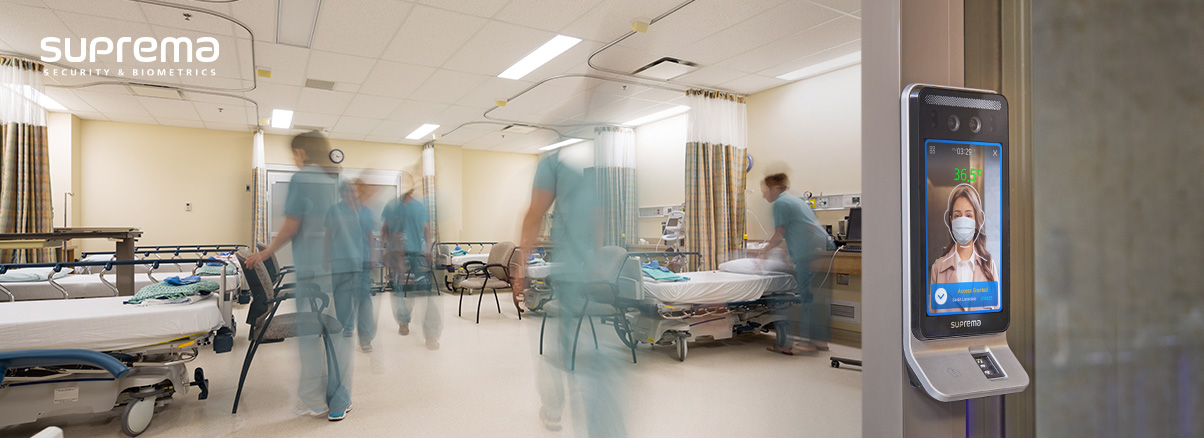- PRODUCTS
- Security Platform
- BioStar X | On-Prem SecurityNEW
- BioStar Air | Cloud Security
- BioStar 2
- Access Control
- Access Control Unit
- Biometric Readers
- RFID Readers
- Mobile Credential
- Peripherals
- Wireless Door Locks
- SOLUTIONS
- SUPPORT
- ABOUT
- device_hubHUB
- Blogs & Articles

Security and safety are crucial to providing optimal patient care at healthcare facilities, from the local doctor’s office to expansive healthcare campuses that include hospitals, clinics, and critical care facilities. Healthcare facilities have unique security and surveillance needs, ensuring the safety of staff, patients, and visitors while maintaining the highest level of privacy protection.
The safety and security of staff, patients, and visitors is a top priority for healthcare facilities. But these facilities are under constant pressure to balance patient safety with managing costs and constant visitor traffic, open access in multiple buildings, hectic emergency departments, confidentiality requirements, governmental and accreditation standards and patient satisfaction scores.
The inability to successfully handle these responsibilities can earn a healthcare facility an unsafe reputation. When creating a solutions-driven and evidenced-based safety and security program, access control must be forefront.
ACCESS CONTROL IN HEALTHCARE FACILITIES
In addition to securing sensitive areas such as maternity wards, emergency departments and intensive care units, asset protection is a significant concern for medical facilities. Prescription medications, medical supplies, and other high-value items are potential targets for theft and must be secured adequately. While the overall demand is to keep a facility secure, other security demands are essential as well. Complying with HIPAA requirements regarding the security of controlled substances, medications and pharmaceutical supplies is critical. One important security concern is complying with The Health Insurance Portability and Accountability Act of 1996 (HIPAA), a federal law that requires healthcare providers to protect sensitive patient health information from being disclosed without the patient’s consent or knowledge.
Also, access-control systems must function seamlessly in multi-department and campus environments. Controlling segmented specialties, such as cardiac, research, emergency and maternity wards, is crucial because all departments have different needs and requirements. However, these same systems must allow authorized staff to move freely and accommodate the many credentials needed by staff and volunteers.
All healthcare facilities face similar challenges: knowing who is inside the facility, monitoring access points, and tracking sensitive material, including drug containers, toxic material, and critical samples for testing. Effective and high-quality solutions that improve the safety and security of any healthcare facility, include:
- Entrances and exits, including employee entrances, public gates, parking areas and limited-access spaces
- Storage areas for drugs or toxic material; plus, tracking functions to ensure proper handling and delivery
- Surgical centers, emergency rooms, and exam rooms
BEST PRACTICES
Healthcare facilities such as hospitals are usually open 24 hours a day, seven days a week, and are required to be accessible to the public. As a result, there are dozens or even hundreds of unknown visitors to a hospital daily. Medical scenarios are often fraught with drama and, inemergencies, emotions can run high on all sides.
Patients (or even family members of patients) can become belligerent or even violent. Cases of quarantine need to be handled quickly and efficiently to prevent the spread of disease. In addition, hospitals are often concerned with patient safety, as parental disputes, power of attorney issues, and mind-altering ailments can lead to patients being abducted, harmed, or going missing.
Furthermore, with pharmaceutical drugs and expensive equipment distributed throughout the premises, hospitals are susceptible to theft and abuse. A robust and comprehensive access control system can improve overall security, decrease hospital liability, and increase patient and staff safety.
Use the following best practices to determine facility needs and selecting the correct combination of access control technologies.
-
Determine the Healthcare Areas and Facilities That Require Security
A keen knowledge of the entire area that must be secured is the first step to developing and maintaining hospital security standards. This point is crucial if the facility covers a large area, whether covering one building or across several smaller spaces. Always remember to include satellite offices when taking inventory.
-
Assess Your Hospital Security Standards and Systems in Place
A thorough, security-focused walk-through of the interior and the facilities grounds and satellite locations, delivers a solid idea of what the facility needs in terms of type and scope of an access control system. Identify all doorways, elevator systems, sensitive areas and more heavily restricted areas to fully understand the access control technology to best suit the needs.
-
Focus First on Card Access Control in the Healthcare Facility
An ideal system will be comprehensive, including video surveillance and monitoring. It is also crucial to identify and fortify access points to prevent unauthorized access. Integrating video surveillance with the access control system offers a robust security combo, but it does come with complications, especially regarding HIPAA’s privacy regulations.
RFID access control readers that support Near Field Communication (NFC) and Bluetooth Low Energy (BLE) can also accept mobile credentials – credentials that reside on a smartphone. This method allows people to use their smartphone as a key to access doors, facilities, and more. By using a smartphone as a credential, managing and using an access card becomes easier, faster, and safer, this technology is contactless and eliminates the need to replace lost cards and key fobs.
-
Incorporate Fire Alarm Monitoring into Your Access Control System
Nearly 30 percent of businesses that use an access control system do not incorporate fire alarm monitoring into the system. This gap in security can create hazards that result in the failure of doorways to open in the event of a fire emergency.
-
Include All Exterior Areas Surrounding the Healthcare Facilities in the Security Plan
Places like parking lots or garages, walkways and entryways are all high-risk areas for potential crime, accidents or anything else that the security team should be aware of.
CHOOSING THE CORRECT ACCESS CONTROL SYSTEM
Access control encompasses a wide breadth of technologies that can be mixed and matched to meet the needs of an individual healthcare facility. A small family practice may require only a keypad entry system to admit access to employees at the entrance and into storage areas. On the other hand, large healthcare campuses may require an extensive system that incorporates video surveillance, fire detection and alert, and a central communication center.
Physical access control systems require unique identification to authenticate and authorize an individual asking for access. Most access control security systems use one of the following identification methods.
Key cards, fobs and badges: With a key card entry system, authorized personnel swipe, tap, or wave their card at a reader to gain entry. Key cards and fobs are supported on most legacy access control systems but can be more difficult and costly to manage. Plus, they require in-person administration.
Physical Access Barriers: Beyond a locked door, there are various elements that can be used to prevent entry to an area. Physical barriers are often used to protect heavily trafficked or vulnerable areas. Barriers that prevent access includeturnstiles, speed gates, security revolving doors, and interlocks.
Biometrics: This more advanced security measure requires users to authenticate with their fingerprint, iris scan, or facial recognition to gain entry. Some access control providers manufacture biometric readers, which can be used in addition to other credentials.
FACE RECOGNITION TECHNOLOGY
The COVID-19 Pandemic has affected every aspect of life, and healthcare facilities large and small must take heightened precautions to ensure employees, visitors, and customers are secure and safe. One way to help stop the spread of any virus is to limit contact with people and surfaces. Most existing access control systems require some contact - physical locks, keypads, fingerprint scanners, and keycard/keyfob readers – that are difficult to keep sanitized.
To prevent the spread of disease, a hospital access control solution should reduce the number of “touchpoints” in a facility. Touchpoints are points of access where a staff member must physically make contact with an object in order to get through, such as a handle, push bar, keypad, or similar security device. In a hospital environment, where the spread of germs is a major concern, touchpoints create a hazardous breeding ground for germs. With the development of new technologies for access control systems, tailored for the healthcare industry, hospitals no longer require many touchpoints, if any at all. For example, access control devices that read and authenticate a credential from a distance remove the need for touching keys or keypads and face-as-a-credential technology that uses a person’s face as their key to access entrances, restricted areas, anywhere the flow of people must be limited.
Facial recognition is the preferred benchmark because the technology is easy to deploy and implement. The interaction with a facial recognition system is contactless, convenient, and fast. While other biometric systems that use hand geometry and iris scans are contactless as well, these systems require more effort on the part of users to correctly position themselves in front of devices for recognition and thus are slower..
Face recognition can be integrated with surveillance cameras into a robust and complete contactless access control system.
Face-as-a-credential offers features such as remote user enrollment that also minimize personal interactions and further help stop the spread of viruses. These systems help prevent the spread of a virus by:
- Detecting people not wearing a mask and issuing a verbal warning.
- Detecting, capturing and recognizing the face of a person wearing a mask.
- Integrating with thermal cameras to identify people with elevated skin temperature.
MEETING THE ACCESS CONTROL CHALLENGE
Access-control devices have evolved to meet the changing needs of healthcare facilities in a world where an exploding population and the threat of increased global pandemics offer unique challenges. But what is the correct mix of technology? Partnering with the correct access control vendor is paramount to implementing an effective access control solution. There are many vendors to choose from, but few offer a comprehensive and robust solution that easily scales as needs grow.
One vendor that meets the challenge is Suprema, a leading global provider of access control solutions that combines renowned biometric algorithms with superior engineering to offer an extensive portfolio that includes biometric access control systems, live fingerprint scanners, mobile authentication solutions and embedded fingerprint modules.It all starts with BioStar 2, a web-based, open, and integrated security platform that provides comprehensive functionality for access control. Featuring a modular, flexible framework, the platform provides a customized system depending on system scale, the number of users and system structure used. The addition of Suprema FaceStation F2, an advanced face recognition terminal, provides true contactless access control with the added benefits of time and attendance management.











